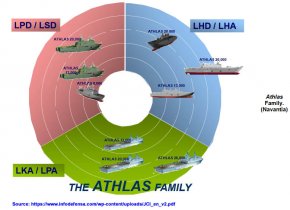An LPD / LPH / or BHS for the RCN would be welcome but crewing will be the challenge. The LST 120 has a 22 person crew and for this reason primarily I feel this provides us a capability we lack at a cost we can afford and manage initially. As time passes and we develop the skills we can look to move to the larger platform. Even the basic vessels such as the Makasaar type have 122 crew each.
You have to start somewhere and you also have to consider the CONOPS that CANDEF and the RCN have. Those CONOPS are the most important consideration. Secondly, the AOPS that the ships will cover also are important. What are the transit areas and distances to be covered? Will the vessels be able to comfortably and safely handle the seas and weather encountered in all seasons? In Canada's case can they operate in the Atlantic, Pacific and Arctic Oceans? Why the Arctic? Because you will need to be able to project force up there as the ice retreats further and the Arctic Ocean is ice free year round.
With many decades as a naval architect and marine engineer, I think that I would find a detailed crewing breakdown for the Makassar-class and LST 120 interesting. If you started adding a helicopter with aircrew to the LST, as was suggested, the 22 would grow. Even a small amount of automation would probably be cost effective at reducing the 121 in the higher crew cost Canadian environment. Also, there could be inconsistencies in who is being counted as “crew.” The devil is in the details with crewing.
IMHO, you want your amphibious ships to be as “military” as you can afford and a ship with a dock is handy. But something is better than nothing and Damen LSTs are certainly way better than nothing. You just have to be careful to not make a major mistake and end up with a ship that needs a lot of work to be satisfactory like HMNZS Canterbury.
Ahh Canterbury. You are right there and it's acquisition and the stuff ups were purely political in nature because the pollies wanted it done on the cheap and didn't listen to the RNZN and the experts. You are correct in that a welldock is a necessity.
As far as platforms go, I would suggest the
Singapore Technologies Endurance series. It's comprised of a LPD E120 / 140 and a LHD E160 / 170, neither of which are large and could be automated. The LHD has spots on the flight deck for 5 medium helicopters, or 2 Chinooks. The Makassar are built for tropical service, but as built, I wouldn't want to serve on them in the roaring forties or furious fifties, so I would think that the design would have to be modified quite a bit for Canadian service. Both the
Navantia LPD and LHDs are scalable, as in the image below.

So there is choice out there. I do recommend the Navantia link that I've provided because it has some good general detail in it. The above graphic was taken from it.

